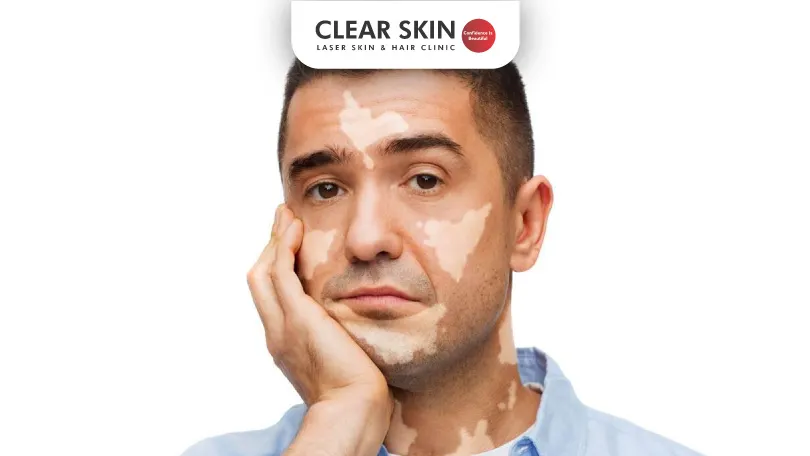Vitiligo: Types, Symptoms, Causes & Treatment
Reviewed By: ![]() Dr Dhananjay Chavan
Dr Dhananjay Chavan
Updated on: 13th Feb, 2023

Vitiligo is a condition that causes the skin to lose a huge part of its natural color. A lot of patches of lighter skin appear. In some cases, only a few patches are developed whereas in other cases, a lot of skin color is lost.
Table Of Content
- What is Vitiligo?
- What are the Types of Vitiligo?
- Who is Affected by Vitiligo?
- What are Causes of Vitiligo
- What are Treatments of Vitiligo
- Conclusion
What is Vitiligo?
Vitiligo is a condition that causes the skin to lose a huge part of its natural color. A lot of patches of lighter skin appear. In some cases, only a few patches are developed whereas in other cases, a lot of skin color is lost.
Vitiligo also ends up affecting other parts of the affected person’s body. For example, an entire section of hair can turn white. Some people also end up losing color inside their mouths. Even an eye can lose some of its colors. However, the cause of this color loss is still unknown to experts in the field.
While Vitiligo is neither life-threatening nor contagious, it is highly impactful on one’s life. In most cases, the patient develops low self-esteem and very low confidence levels as well. It can easily be treated, so do not worry if you develop vitiligo.
What are the Types of Vitiligo?
The most common type of Vitiligo is the Non-segmental vitiligo and is found in up to 90 percent of cases.
In the cases of non-segmental vitiligo, the patches often appear equally on both sides of the body and are also symmetrical. In most of the cases, these spots appear on parts of the skin which is commonly exposed to the sun, such as the face, neck, and hands.
Common areas include:
- Backs of the hands
- Arms
- Eyes
- Knees
- Elbows
- Feet
- Mouth
- Armpit and groin
- Nose
- Navel
- Genitals and rectal area
However, patches can also appear in other areas.
Non-segmental vitiligo can further be divided into the following sub-categories:
1.Generalized: This type of non-segmental vertigo is not confined to a certain specific area or the size of patches. This is the most common type of non-segmental vertigo.
2.Acrofacial: The vitiligo that appears most on the fingers or toes is acrofacial.
3.Mucosal: The mucosal vitiligo appears mostly around the mucous membranes and lips.
4.Universal: This occurs in extremely rare cases. But, in such a scene depigmentation covers most of the body.
5.Focal: One or a few scattered white patches would develop in a discrete area. This type of vitiligo is mostly found in very young children.
Who is Affected by Vitiligo?
Vitiligo basically affects indiscriminately both- the male and the female population of this planet, and is not dependent on the prototype of the skin or the race. There is no particular age at which one can get vitiligo. However, it is commonly found in people who are affected by other autoimmune diseases such as thyroid malfunction, diabetes, alopecia areata, megaloblastic anemia, etc.
Most incidence ranges from 1% to 2% in most populations, but only with the exception of areas such as India and South America in which there is an existing genetic and environmental impact. (e.g. humidity, temperature, and sunshine).
In these regions, the vitiligo affected patients are found to be at numbers ranging up to 8.8 % of the population. It is observed that 20-38% of the patients have first and second degree relatives who are also known to suffer from vitiligo.
What are the Causes of Vitiligo?
In a nutshell, Vitiligo is said to develop whenever the cells called melanocytes die. These cells give our skin and hair color. Scientists do not completely understand the reason behind the death of these cells. The most common type of vitiligo is said to be an autoimmune disease. An autoimmune disease basically develops whenever the body starts mistaking a part of itself to be foreign. If the body mistakes melanocytes to be foreigners, it will attack and kill these cells.
Studies also suggest that the other type of vitiligo, segmental vitiligo, has a different cause. This type seems to develop when something in the body’s nervous system goes awry.
What are the Treatments of Vitiligo?
Although not medically harmful, the white patches can sometimes cause emotional distress. Most of the treatments for vitiligo are designed to help restore color to the white patches appearing on the skin. For some people, treatment ends up making the skin color look more even, but a lot of treatments can have various unwanted side effects. Medical treatments can include:
- Medicines or medicated skin creams.
- Tattooing small areas of skin.
- A combination of ultraviolet light treatment and medicine.
- Surgery, when topical creams and light therapy do not work.
- Removing the color from dark areas of the skin so they match the white patches
You should visit experts at clinics like Clear Skin to get the right guidance on the diagnosis. While most medications are prescribed, they do not prove to be beneficial. Here, you can find the right surgical techniques to get rid of your problem.
Do You Know?
Roughly 250 Patients Are Treated
Everyday By These Dermatologists
(You are one click away from flawless skin)
Meet Our Dermatologist!
Conclusion
Further Reading
Best Acne Spot Treatments
Acne spots are marks left behind after acne breakouts, ranging from redness to hyperpigmentation. Find the best treatments for clear skin.
How to Avoid Acne in Monsoons?
Avoid acne in monsoons with a gentle skincare routine, diet tips, and hydration. Get expert advice to manage breakouts and keep your skin clear and healthy.
Does Makeup Cause Acne-Prone Skin?
Worried about breakouts from using makeup? Does makeup cause acne for you? Learn the safe ways to apply makeup for acne-prone skin.
Morning Skin Care Routine for Glowing Skin
Clear Skin Clinic, led by top dermatologists, shares the ideal morning skincare routine to help you achieve a radiant complexion naturally and effectively.
Have thoughts? Please let us know
We are committed not only to treating you, but also educating you.





